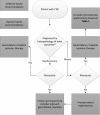2012 CUA Abstracts
Erratum in
-
CUA Annual Meeting Abstracts addition.Can Urol Assoc J. 2012 Aug;6(4):244. doi: 10.5489/cuaj.12208. Can Urol Assoc J. 2012. PMID: 23093531 Free PMC article.
Abstract
Introduction and objectives: The management of kidney stone disease has changed dramatically over the past 30 years. In particular, ureteroscopy (URS) has become a more efficacious procedure with less morbidity. As a result, based on physician surveys and reports from single centre series the rate of URS appears to have increased over time. However, large population-based evaluations to assess the changes over time in the surgical treatment of kidney stone disease have not been conducted. Our objective was to evaluate population-based trends in the use of extracorporeal shockwave lithotripsy (SWL), URS and percutaneous nephrolithotomy (PCNL) over the past 20 years, in Ontario.
Methods: Using the Ontario Health Insurance Plan physician claims database we conducted a population-based cross-section time series analysis by identifying all kidney stone treatments performed between July 1, 1991 and Dec. 31, 2010, in the province of Ontario. The primary endpoint was the proportion of all stone treatments represented by each modality, which was calculated for every 3-month block over the study period. Exponential smoothing models were utilized to assess for trends over time in the percent utilization of each of SWL, URS and PCNL.
Results: We identified 194,781 kidney stone treatments between July 1, 1991 and Dec. 31, 2010. A total of 96,807 SWL treatments, 83,923 URS treatments and 14,051 PCNL treatments were performed. We observed a significant trend over time for decreased utilization of SWL (68.5% to 33.7%, p<0.0001) and an increase in URS utilization (24.6% to 59.5%, p=0.0002), while no change over time was found for PCNL (6.88% to 6.85%, p=0.97) (Fig. 1). By the end of 2004, URS had become the most widely used procedure.
Conclusions: Our population-based study confirms the increased use of URS over time suggested by physician survey and single centre retrospective series. Accordingly, the utilization of SWL has decreased in a reciprocal fashion.
Figures
Similar articles
-
Surgical Stone Trends from 2013 to 2021 in the US Medicare Population: Before and after the COVID-19 Pandemic.J Endourol. 2024 Sep;38(9):902-907. doi: 10.1089/end.2024.0063. Epub 2024 Jul 4. J Endourol. 2024. PMID: 38874511
-
Long-term evaluation of outcomes and costs of urolithiasis re-interventions after ureteroscopy, extracorporeal shockwave lithotripsy and percutaneous nephrolithotomy based on German health insurance claims data.World J Urol. 2022 Dec;40(12):3021-3027. doi: 10.1007/s00345-022-04180-3. Epub 2022 Oct 14. World J Urol. 2022. PMID: 36239809 Free PMC article.
-
Endourologic Management (PCNL, URS, SWL) of Stones in Solitary Kidney: A Systematic Review from European Association of Urologists Young Academic Urologists and Uro-Technology Groups.J Endourol. 2020 Jan;34(1):7-17. doi: 10.1089/end.2019.0455. Epub 2019 Sep 26. J Endourol. 2020. PMID: 31456421
-
Combined ureterorenoscopy and shockwave lithotripsy for large renal stone burden: an alternative to percutaneous nephrolithotomy?J Endourol. 2005 May;19(4):464-8. doi: 10.1089/end.2005.19.464. J Endourol. 2005. PMID: 15910257
-
Trends of intervention for paediatric stone disease over the last two decades (2000-2015): A systematic review of literature.Arab J Urol. 2017 Nov 20;15(4):306-311. doi: 10.1016/j.aju.2017.10.006. eCollection 2017 Dec. Arab J Urol. 2017. PMID: 29234533 Free PMC article. Review.
LinkOut - more resources
Full Text Sources
Research Materials
Miscellaneous









